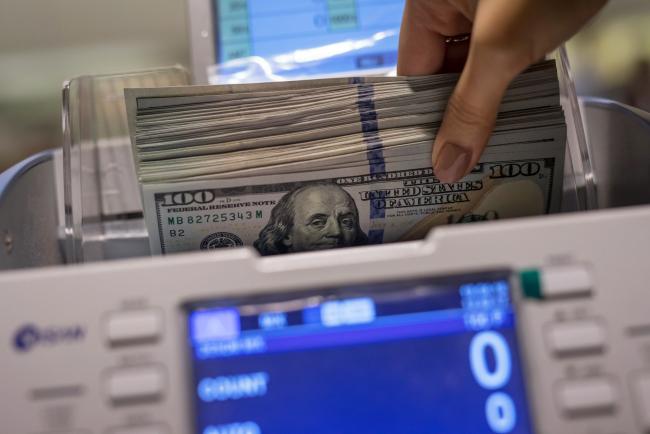(Bloomberg) -- Terms of Trade is a daily newsletter that untangles a world embroiled in trade wars. Sign up here.
The yuan is collapsing and traders think that’s going to spur a quick rate-cut reaction from the Federal Reserve. But whether that gives Donald Trump what he seems to covet -- a weaker dollar -- amid the escalating U.S.-China trade war is far from certain.
China let the yuan plunge on Monday to the weakest level in more than a decade, intensifying the dispute and prompting Trump to indicate he’d like a Fed response.
Amid this backdrop, traders brought forward when they think the central bank will complete a half-point of cuts, now forecasting that will happen by the end of October, versus January two days ago. That drove the greenback down against Group-of-10 currencies including the Swiss franc, euro and yen on Monday.
If the Fed does follow up last week’s rate cut with more easing, havens like the franc and yen might continue to strengthen, but the dollar would only marginally weaken against the euro, according to Deutsche Bank (DE:DBKGn) strategist Alan Ruskin.
“You need pretty large currency moves to have a meaningful impact on the economy,” Ruskin said. So far, the magnitude of the moves in the euro and other currencies is “just not large enough to have the kind of real economic effects that would be very helpful for the U.S. economy.”
The U.S. government upped the ante late Monday by labeling China a currency manipulator. While the dollar weakened as much as 0.4% against the yen early in Asia Tuesday, those losses were reversed after China set the yuan reference rate stronger than analysts expected.
READ: China Acts to Limit Yuan Plunge After Being Labeled Manipulator
“Even if the situation with China were to be resolved quickly, the lingering uncertainty over the unpredictability around President Trump and his trade policy will likely weigh on the pace of activity,” said Maximillian Lin, an emerging-markets Asia strategist at NatWest Markets in Singapore. “In the face of increasing downside economic risks, the need for more monetary policy ‘insurance’ is growing.”
Traders expect the Fed to reduce rates by 100 basis points over the next 12 months. Cuts, Ruskin said, will cause the dollar to strengthen against G-10 commodity currencies, notably the Australian dollar, which is aligned with China’s economic growth.
The greenback strengthened to 7.05 yuan on Monday after breaking the key 7-per-yuan level. The U.S. dollar has outperformed all G-10 currencies this year besides the Canadian dollar, yen and franc. To the dismay of Trump and dollar bears, the Bloomberg dollar index climbed to a two-month high on July 31 after the Fed cut interest rates by 25 basis points.
“Trump’s frustration with the currency market will continue to build,” Paresh Upadhyaya of Amundi Pioneer Asset Management said in an email. “This frustration has been building” with the dollar rallying after last week’s Fed reduction and now appreciating against the yuan and most emerging-market currencies, he said.
Upadhyaya said the new tariffs Trump recently announced -- a 10% levy on an additional $300 billion of Chinese goods -- will prompt the Fed to cut again at the September meeting and raises the prospect of another one in December. The investor is cautious about selling the euro, swiss franc and yen.
(Adds comment from strategist in the seventh paragraph, updates prices throughout.)
